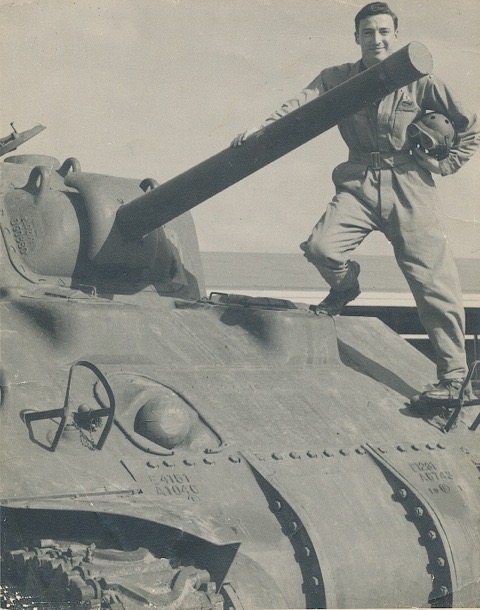|
Battle of the Bulge
Skip to Part 2 Notes
Part 1 Notes
- 00:00-03:26 - Introductory Section
- 00:00-00:36
- He addresses the memoir to someone named Rafael who intends to write a book in English about the Battle of the Bulge "from a different perspective". I have not found who Rafael is nor what book he wrote. Rafael was apparently a resident of Belgium or maybe Luxembourg who might have written in French or German but chose to write in English.
- He mentions Bruce Harrison. I have not found who Bruce Harrison was.
- 01:30-01:50
- He refers to the U. S. Army Armor School study "The Defense of St. Vith, Belgium 17-23 December 1944: An historical example of armor in the defense". This book is available on Amazon.com. See this link for more information.
- 01:55-03:26
- He refers to the supporting documentation for the Presidential Unit Citation. The original PUC submission included the entire 7th Armored Division and most attached units. However, it was not submitted until 1948 after an administrative decision to stop authorizing PUC awards to entire divisions. So, a PUC was submitted and awarded for Combat Command "B" and most attached units. The book "7th Armored Division Presidential Unit Citation, St. Vith, Belgium, December 1944: Recommendation, Supporting Documents, Combat Command "B" Citation" contains the original full-division supporting documentation. This book is available on Amazon.com.
- 03:27-10:38- Move to St. Vith (17 Dec)
- 03:27-04:19
- He gives their position prior to the move. They were at Geilenkirchen, with combat at Linnich and Lindern. Click here to see these locations on Google Maps.
The Division's elements straddled both sides of the Netherlands-German border, with the western units completely out of combat. Some elements of the units in Germany were attached to the 104th Infantry Division for the attacks on Linnich. Even after the war, men in the western units had not realized that men in the eastern units were dieing in combat that the western-unit men never knew about. 17th Tank Battalion was the northernmost of the eastern units. 38th Armored Infantry Battalion (also in Combat Command R) was south of Geilenkirchen at Ubach, Germany.
- 05:32-06:13
- As he notes, 7th Armored Division moved south in an east and a west column. Combat Command R (to which 17th Tank Battalion was then attached) was the main element of the eastern column, followed by Division Artillery and some elements of 203rd Anti-Aircraft Artillery Battalion.
Their route was roughly Ubach to Aachen to Eupen to Malmedy to Recht and Nieder- and Ober-Emmels (lower and upper). Click here to see these locations on Google Maps. (Note: this is a rough map of their route and not their exact route. The modern super-highways did not exist at that time.)
- 06:24-07:03
- He says that he was at the head of the column. What he means is 17th Tank Battalion's column within the Eastern Column. In fact, 38th Armored Infantry Battalion preceded 17th Tank Battalion in the line of march.
- 07:04-07:50
- He describes moving through the town of Malmedy and mentions the Malmedy Massacre. It seems that even by 1990 he was not aware just how close he came not just in place but in time to the Malmedy Massacre. The Massacre took place at the crossroads of Baugnez, 2.5 miles south of Malmedy. It should be called the Baugnez Massacre. It came to be called the Malmedy Massacre because survivors made their way from Baugnez to Malmedy, so that the first report of the Massacre came from Malmedy. Click here to see these locations on Google Maps.
The German Kampfgruppe (Battle Group) Peiper moving west intercepted the 7th Armored Division's Eastern Column at Baugnez. However, because the column had stretched out as it moved south, the 285th Field Artillery Observation Battalion entered the 7AD column at Eupen. The 285 FAOB stopped for lunch along the route, and when they re-entered the 7AD Eastern Column, they wound up between the trailing elements of 17th Tank Battalion behind them and the rest of 17th Tank Battalion -- and Maj. Dailey -- ahead of them. Thus it was the lightly-armed 285 FAOB that KG Peiper attacked and captured and not the tanks of the 17th Tank Battalion, which had passed through the crossroads a very short time before.
There were many "what if?" situations in World War II, and this was one of them. What if KG Peiper had arrived 15-30 minutes earlier at the crossroads and it had been the tanks of 17th Tank Battalion passing through in single file?
The last elements of 17th Tank Battalion had to turn back north and return to Malmedy. All of the 7th Armored Division Artillery also had to alter their route and head west in order to reach the rest of the Division. This took a couple of days, so that 7th Armored Division had limited artillery support as the defense of St. Vith began.
- 07:51-08:25
- He says that they set up an initial administrative bivouac north of St. Vith. The After-Action Report says this was just south of Recht, Belgium.Click here to see this location on Google Maps.
The 17th Tank Battalion Headquarters Morning Report for 17 Dec 1944 gives the location as Recht, Belgium VP 8194 and gives this Record of Events: "Left bivouac at Boscheln (outskirts of Ubach) Germany at 0830, passing thru Aachen, entered Belgium and passed thru Eupen, Malmedy, Lignueville and pulled into bivouac 1 mile east of Recht, Belgium. Nord De Guerre Grid Zone VP 8194"
- 08:26-10:38
- He describes the challenge several miles south of Malmedy by American soldiers who had a ropeline of land mines across the road. It is not clear what unit these soldiers were in. Presumably 7th Armored Divison Military Police would have been stationed along the route, but he does not say who these soldiers were. The challenge was necessary because Germans in American uniforms had been discovered, so that any troops in American uniforms had to prove that they truly were American troops and not Germans in disguise. This is the first I have learned of men making the challenge this early (early afternoon of 17 Dec 1944) in the battle. All other references to challenges that I have heard of were after they had arrived in the St. Vith area.
- He warns the men with the land mines that he is followed by the rest of an armored division. But that section of road would already have been traversed ahead of him by 38th Armored Infantry Battalion. So, the men with the mines would also have stopped 38 AIB. In fact, the only elements behind 17th Tank Battalion in the Eastern Column were Division Artillery, elements of 203rd Anti-Aircraft Artillery Battalion and some support units. 7th Armored Division's Combat Commands A and B, with the bulk of the combat elements of the Division, were in the Western Column.
- 10:39-15:59- Setting up a defense against attack from the East (17 Dec)
- 10:39-12:23 - Setting Up the Bivouac (17 Dec)
- He describes their bivouac as straddling a road, with the radio halftrack set up outside a house. They positioned Service Company to the rear, which they presumed to be to the west. The 17th Tank Battalion Headquarters Morning Reports of 17-19 Dec 1944 all list their location as Recht, Belgium VP 8194. Here is a map of that grid square (click on the map for full size) outlined in red.
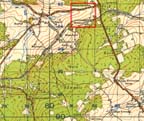
Ober- and Nieder-Emmels are in the lower right, with St. Vith just down the road from them. He said that they pulled off the road to Ober/Nieder-Emmels on a road east of Recht. Only one road in the grid square leaves the main N-S road, the dashed red road going through Kasierbaracke. Based on the After-Action Report, they probably then moved south from Kaiserbaracke along the lesser road (solid line one side, dashed line other side) that crossed over the railroad (alternate black and white bar line). The Morning Reports place them as shown on the map above, with these locations for all of the elements. (Note: see below since After-Action Report gives different [one grid square to the south] and more precise locations.)
- VP8094 (to the west of VP8194) was A/17 and (presumably furthest west) Med/17 and Sv/17.
- VP8194 was Bn HQ/17, HQ Co/17, D/17 (light tanks).
- VP8193 (to the south) was C/17.
- The only exception was B/17, which was 4 miles east of Recht at VP8494.
- 12:24-15:59 - Reports of Germans in Malmedy + Defensive Positions (17 Dec)
- He tells of reports of Germans having taken Malmedy. He sends Reconnaissance Sergeant Sayles (S/Sgt. Merrel W. Sayles of the Reconnaissance Platoon in Headquarters Company) back toward Malmedy to see if it is true. He recalls that after about 45 minutes Sgt. Sayles returned and reported that he made it to the outskirts of Malmedy and heard gunfire there. It appears from his account that Maj. Dailey had heard the initial report of Germans in Malmedy late in the afternoon, so that Sgt. Sayles' reconnaissance took place in the later afternoon. Sunset was about 4-4:30 PM, according to varying accounts.
- In reality, Malmedy never was taken by the Germans. According to John Bauserman in his book "The Malmedy Massacre", Kampfgruppe (Battle Group) Peiper had taken the Baugnez crossroads about 1 PM. The Spitze (Point) led the KG Peiper column and first encountered the Americans at Baugnez, south of Malmedy, followed by the command group and the main body of KG Peiper. After taking the Americans, Lt. Col. (Obersturmbannfuehrer) Jochim Peiper order the Spitze to proceed south to Ligneuville and never moved any of his forces north toward Malmedy. His mission was a fast deep penetration, so that he sought to bypass American strongpoints.
- Thus, it seems nearly impossible that Sgt. Sayles made it as far north as the outskirts of Malmedy since by late afternoon the first elements of KG Peiper's elongated column had not only taken the Baugnez crossroads but also moved south to Ligneuville and then west towards Stavelot. So, it seems most likely that Sgt. Sayles reached the outskirts of Ligneuville, about 5 miles north of their bivouac and thought that he was on the outskirts of Malmedy when in fact he was 5 miles south of Malmedy. The fact that Sgt. Sayles did not report seeing any Germans probably meant that he did not make it all the way to Ligneuville, so that he was even further south from Baugnez.
- John Bauserman places the shooting of the prisoners at Baugnez at some point between 1PM and 2 PM. It seems likely that it was closer to 2 PM. But Baugnez was about 2.5 miles north of Ligneuville, so that Sgt. Sayles probably never made it north of Ligneuville. Still, the firing 2.5 miles away might have been what he heard and assumed to have been at Malmedy. John Bauserman states that it took another 15-20 minutes after the Massacre for the Germans to kill any survivors who appeared to be alive. And then as the trailing elements of the column moved past later in the day they fired on the bodies in the field at Baugnez until 4 PM (which gives some idea of the huge size of KG Peiper, since it took them three hours to move through the Baugnez crossroads. At some point, some American survivors did try to escape, with some taking refuge in the Cafe that the Germans burned and then shot those who came out. Other survivors did run for it and were shot at but made it to Malmeday where they reported the Massacre. I have not yet found what time these escapes and the first report at Malmedy happened.
- In any event, by the time Sgt. Sayles made his reconnaissance in late afternoon, the shooting he heard was probably at Baugnez, which was 2.5 miles north of Ligneuville, so that he probably assumed it was at Malmedy.
- The 17th Tank Battalion After-Action Report is explicit: "By 1500 we had contacted Artillery elements of the 106th Infantry Division and learned that the enemy was in the town of Lignerville [sic] ...
- . It seems likely that the officer Maj. Dailey encountered was from the 106th Infantry Division artillery and that Sgt. Sayles in fact confirmed the German presence in Ligneuville.
- The 17th Tank Battalion After-Action Report also reports the Germans were in Born, which was a short distance east of C/17's position.
- The 17th Tank Battalion After-Action Report provides the specific positions of each element of the Battalion:
- The Battalion CP was set up in the vicinity of 810931.
- Company "C" was deployed generally along a line from 808934 to 811940.
- Company "A" was deployed along line 807933 to 801929.
- Service Company was just to the rear of Company "A".
- Company "D" was assembled in the vicinity of 810931 to protect to the rear and act as a reserve to fill in anywhere needed. A section of tanks from Company "D" was placed in the vicinity of 820921 to block the trail form the east.
- Company "B" was moved to the vicinity of 820935 to protect our right flank. Company "B" established a road block at 826936 with one platoon of tanks and another block at 829916 with another platoon.
- These positions clearly differed from the initial bivouac and the defense to attack from the east. The front is now to the west and the rear to the east. The command post has moved from grid square 8194 to 810931. The house for the command post appears to have been the house circled on this map that shows all of the above positions. (Click on the map showing full size.) In particular, the location of C/17 has shifted from 4 miles east of Recht to a defensive line much closer to Recht. It is not clear why the Morning Reports gave different locations, but the more specific locations in the After-Action Report are probably more reliable than those in the Morning Reports in this case.
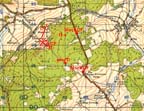
- The 17th Tank Battalion After-Action Report describes the defensive terrain: "The terrain on which we were set up was higher than the town of Recht and was a fairly good position to defend from an attack from the north and northwest, but our flanks and rear were very vulnerable to a dismounted infantry attack for the area was wooded. The railroad track to our front was a tank barrier for it was on a high grade and the road to Recht passed under the railroad to our immediate front, this was the logical avenue of approach to our position from the town of Recht and we had this point adequately covered by fire."
- 16:00-24:05 - Attacked from the West (18 Dec)
- 16:00-24:05 - Attacked from the West (18 Dec)
|
|
Ruhr Pocket
|
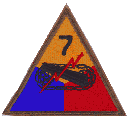

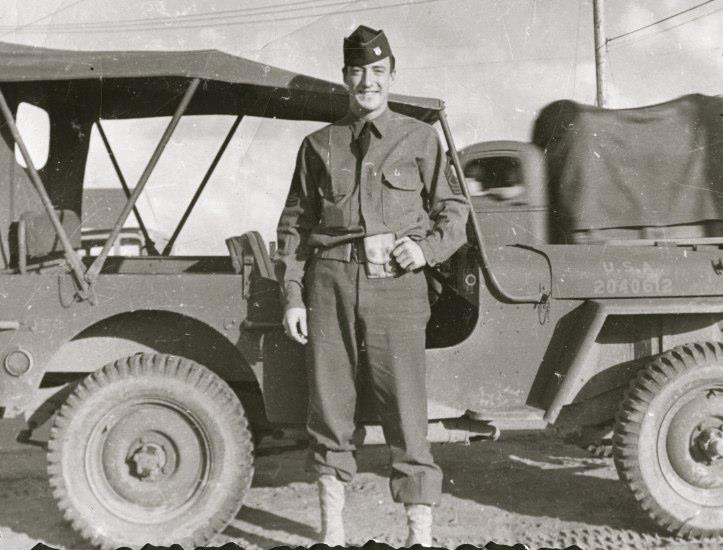 .
. 